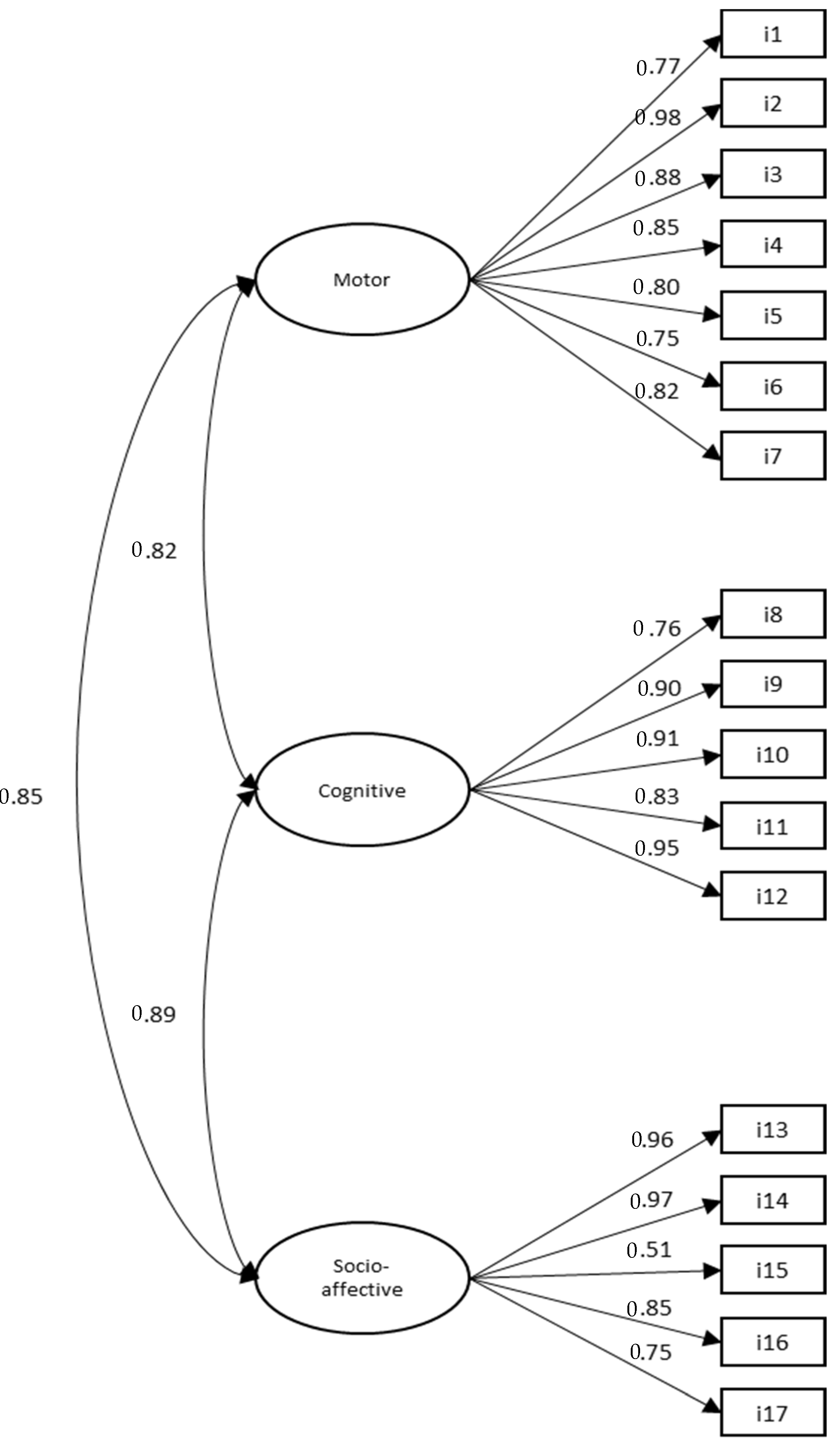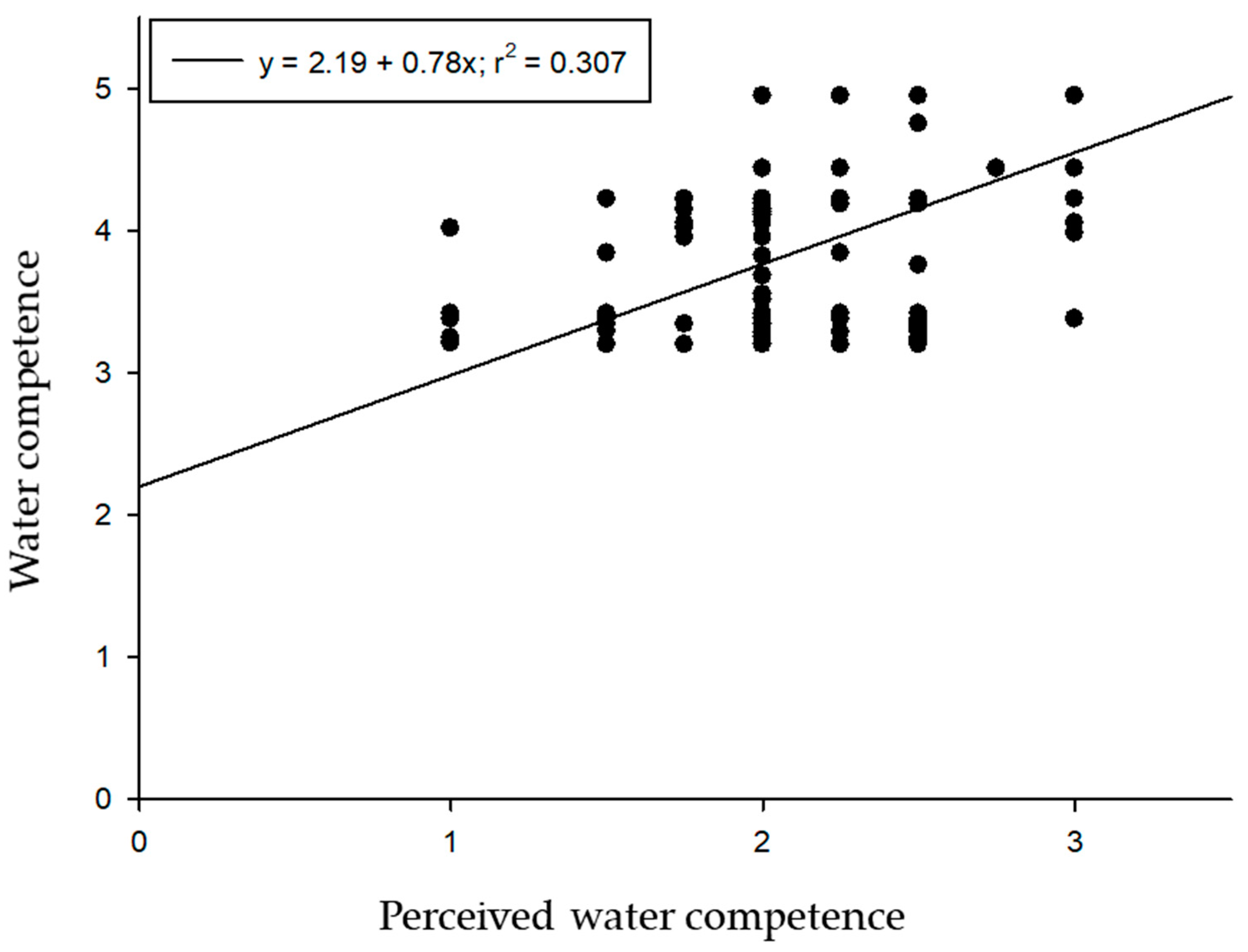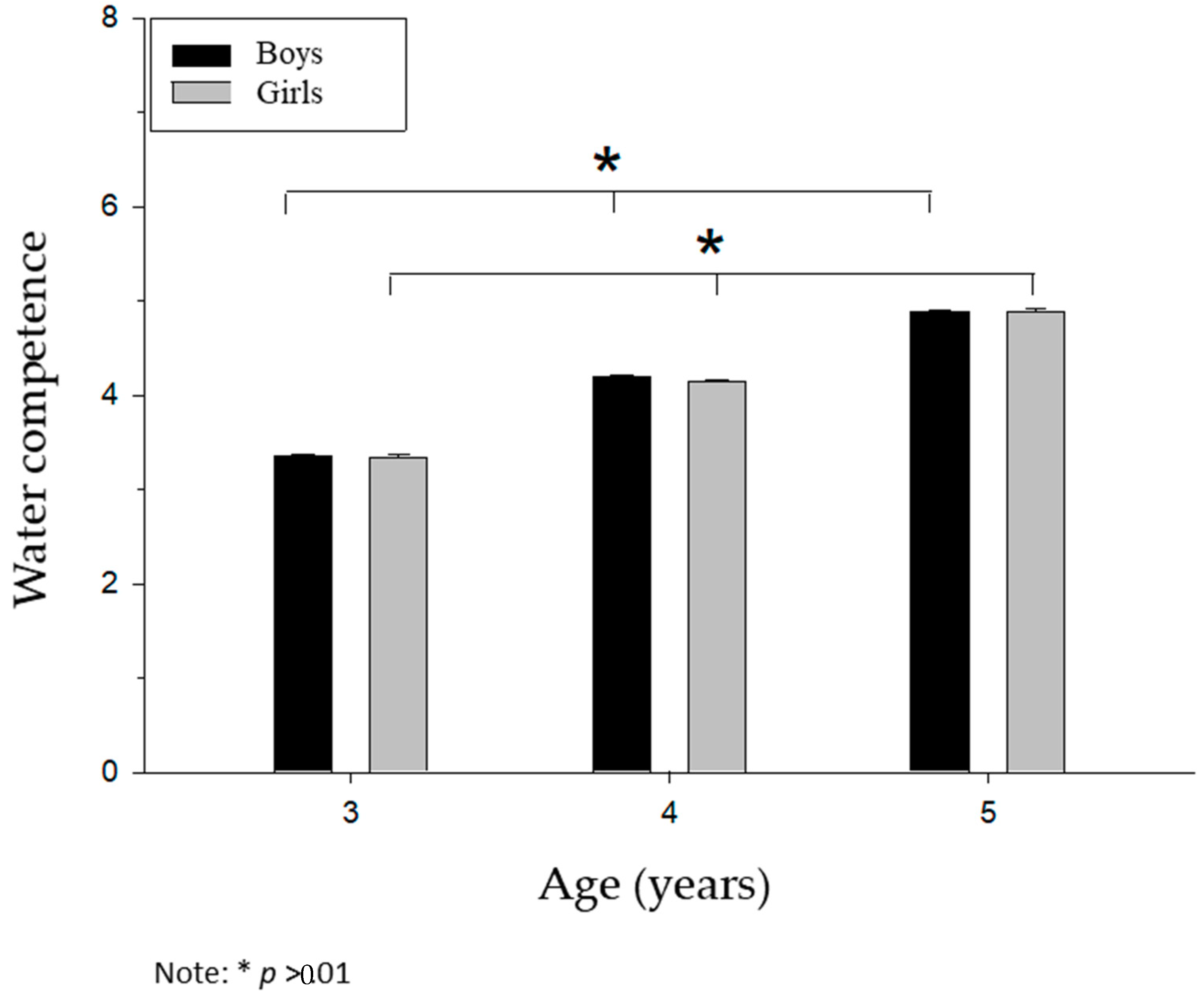Design and Validation of the Scale to Measure Aquatic Competence in Children (SMACC)
Abstract
:1. Introduction
1.1. Dimensions of Aquatic Competence
1.2. Measure of Aquatic Competence
1.3. This Study
1.4. Study 1
2. Materials and Methods
2.1. Ethics Statement
2.2. Participants
2.3. Procedure
2.4. Data Analysis
3. Results
3.1. Construction of the Instrument
3.2. Study 2
4. Materials and Methods
4.1. Participants
4.2. Measures
Aquatic Competence
4.3. Procedure
4.4. Data Analysis
5. Results
5.1. Analysis of Internal Consistency
5.2. Study 3
6. Materials and Methods
6.1. Participants
6.2. Measures
6.2.1. Aquatic Competence
6.2.2. Perceived Aquatic Motor Ability
6.3. Procedure
6.4. Data Analysis
7. Results
7.1. CFA
7.2. Descriptive Analysis and Bivariate Correlations
7.3. Differential Analysis of Real Aquatic Competence by Sex and Age
8. Discussion
9. Conclusions
Author Contributions
Funding
Conflicts of Interest
Appendix A
| Motor Area | |
| 1. Breathing. When the children in the shallow end are asked to make bubbles under the water by releasing air through the mouth and the nose… |
|
| 2. Dorsal balance. When the children are asked to float in star shape in dorsal position… |
|
| 3. Manipulation. When children are asked to pick up different objects in the deep end and take them to the edge of the pool… |
|
| 4. Ventral movement. When the children are asked to move ventrally, using their hands and legs to move and look for toys that are at different distances without immersion… |
|
| 5. Turns. When the children are asked to do a somersault (transversal axis) without pushing off from the floor… |
|
| 6. Dorsal movement. When indicated the child has to move in dorsal position… |
|
| 7. Immersion. When a child is asked to go through the hoops placed at different depths… |
|
| Cognitive Area | |
| 8. Body schema. The particpants are told that they are going to play “catch”. The teacher will indicate the part of the body that they have to touch to be considered caught, and the part of their body to touch with … |
|
| 9. Temporality. We are going to play with drums, we have to make music, beating the board with our hands. The teacher will indicate when they have to beat harder or softer, to mark a fast or slow rhythm. |
|
| 10. Autonomy. Whe the class was over the boys/girls had to put on their bathrobe pr towel and sandals to go to the changing room… |
|
| 11. Reasoning. When a child is asked to pick up the puzzle pieces and take the to the edge to make a mat… |
|
| 12. Oral language. We’re going to tell a story, the teacher begins, and each child should indicate the next action in the story… |
|
| Socio-Affective Area | |
| 13. Communication In two heterogeneous groups, the teacher encourages the children to build a castle or tower with material available in the pool, carrying it from one side to the other in the shallow end of the pool. As the activity develops, the children are asked: How do you feel about working with your team?... |
|
| 14. Solving conflicts (ability to interpret a conflict and find alternative solutions). When the child goes into the changing room, the beach area … |
|
| 15. Self-control (ability to interpret own beliefs and feelings and control impulses) When the child goes into the water … |
|
| 16. Self-control (ability to interpret own beliefs and feelings and control impulses) Playing hide-and-seek, the children have to hide their face in the water, the child reacts… |
|
| 17. Self-control (ability to interpret own beliefs and feelings and control impulses) When it is proposed that the child jumps into the water… |
|
References
- Moreno-Murcia, J.A.; Ruiz, L.M. Cómo Lograr la Competencia Acuática; Sb: Buenos Aires, Argentina, 2019. [Google Scholar]
- Ruiz, L.M.; Rioja, N.; Graupera, J.L.; Palomo, M.; García, V. GRAMI-2: Desarrollo de un test para evaluar la coordinación motriz global en la Educación Primaria. Rev. Iberoam. Ps. Ejerc. Dep. 2015, 10, 103–111. [Google Scholar]
- Langendorfer, S.; Bruya, L.D. Aquatic Readiness: Developing Water Competence in Young Children; Human Kinetics: Champaign, IL, USA, 1995. [Google Scholar]
- Martins, M.; Costa, A.M.; Marinho, D.A.; Barbosa, T.M. Baby Swimming and Motor Skills Achievement. In Book of Abstracts of the 6th International Symposium Science y Swimming; Wroclaw, Poland, 2012; p. 4. [Google Scholar]
- Brenner, R.; Moran, K.; Stallman, R.; Gilchrist, J.; McVan, J.T. Swimming ability, water safety education, and drowning prevention. In Handbook on Drowning: Prevention, Rescue, Treatment; Springer: Berlin, Germany, 2006. [Google Scholar]
- Moreno, J.A.; De Paula, L. Estimulación Acuática Para Bebés; INDE: Barcelona, Spain, 2009. [Google Scholar]
- Stallman, R.K. From Swimming Skill to Water Competence: A Paradigm Shift. Int. J. Aquat. Res. Educ. 2017, 10. [Google Scholar] [CrossRef] [Green Version]
- Stallman, R.K.; Moran, D.K.; Quan, L.; Langendorfer, S. From swimming skill to water competence: Towards a more inclusive drowning prevention future. Int. J. Aquat. Res. Educ. 2017, 10, 3. [Google Scholar] [CrossRef] [Green Version]
- Morán, K. Defining ‘Swim and Survive’ in the Context of New Zealand Drowning Prevention Strategies: A Discussion Paper; WaterSafe Auckland: Auckland, New Zealand, 2013. [Google Scholar]
- Gómez-García, M. Problemas Evolutivos de Coordinación Motriz y Percepción de Competencia en el Alumnado de Primer Curso de Educación Secundaria Obligatoria en la Clase de Educación Física; Universidad Complutense de Madrid, Servicio de Publicaciones: Madrid, Spain, 2015. [Google Scholar]
- Maeland, A.F. Self-esteem in Children with and without Motor Coordination Problems. Scand. J. Educ. Res. 1992, 36, 313–321. [Google Scholar] [CrossRef]
- Moreno, J.A.; Ruiz, L.M. Aquatic perceived competence in children: Developmen and preliminary validation of a pictorical scale. Int. J. Aquat. Res. Educ. 2008, 2, 313–329. [Google Scholar]
- Ruiz, L.M.; Linaza, J.L. Motor skills, motor competence and children: Bruner’s ideas in the era of embodiment cognition and action. In Jerome, S. Bruner Beyond 100; Springer: Cham, Switzerland, 2015; pp. 113–122. [Google Scholar]
- Moreno-Murcia, J.A.; Huéscar, E.; Polo, R.; López, E.; Carbonell, B.; Meseguer, S. Efecto de los cuentos en la competencia acuática real y percibida en infantes. Rev. Int. Med. Cienc. Act. Fís. Dep. 2016, 3, 35–46. [Google Scholar]
- Moreno-Murcia, J.A.; Huescar, E.; Parra, J.A. Acquisition of Aquatic Motor Skills through Children’s Motor Stories. Int. J. Aquat. Res. Educ. 2017, 10, 1. [Google Scholar] [CrossRef] [Green Version]
- Morgado, L.D.S.; De Martelaer, K.; D’Hondt, E.; Barnett, L.M.; Costa, A.M.; Howells, K.; Sääkslahti, A.; Jidovtseff, B. Pictorial Scale of Perceived Water Competence (PSPWC): Testing Manual, 1st ed.; Early Years SIG AIESEP: Madrid, Spain, 2020. [Google Scholar]
- Azemar, G. Puer aquaticus ou lenfant á la conguête dune autonomie precose dans leau. Med. Sport 1976, 50, 4. [Google Scholar]
- Erbaugh, S.J. Assessment of swimming performance of preschool children. Percept. Mot. Ski. 1978, 47, 1179–1182. [Google Scholar] [CrossRef] [PubMed]
- Le Camus, J. Aspects pedagogiques d’une experience d’aptation de jeune enfant au melieu aquatique. Educ. Phys. Sport 1974, 129, 42–50. [Google Scholar]
- Varveri, D.; Flouris, A.D.; Smirnios, N.; Pollatou, E.; Karatzaferi, C.; Sakkas, G.K. Developing and testing an instrument to assess aquaticity in humans. J. Bodyw. Mov. Ther. 2016, 20, 497–503. [Google Scholar] [CrossRef] [PubMed]
- Moreno, J.A. Desarrollo y validación preliminar de escalas para la evaluación de la competencia motriz acuática en escolares de 4 a 11 años. RICYDE Rev. Int. Cienc. Dep. 2005, 1, 14–27. [Google Scholar]
- Salar-Andreu, C.S.; Moreno-Murcia, J.A.; Ruiz-Pérez, L.M. Validación del inventario evolutivo acuático IDEA de 6 a 12 meses/Validation on the Inventory of Evolutionary Aquatic Development IEAD (IDEA) in 6 To 12 Month Old Babies. Rev. Int. Med. Cienc. Act. Fís. Dep. 2018, 18, 555–576. [Google Scholar] [CrossRef] [Green Version]
- Chan, D.K.; Lee, A.S.Y.; Macfarlane, D.J.; Hagger, M.S.; Hamilton, K. Validation of the swimming competence questionnaire for children. J. Sports Sci. 2020, 1–8. [Google Scholar] [CrossRef] [PubMed]
- Mira, J.E.B.; Padrón, A.L.; Andrés, S.M. Validación mediante el método Delphi de un cuestionario para conocer las experiencias e interés hacia las actividades acuáticas con especial atención al Winsurf. Ágora Educ. Fís. Dep. 2010, 12, 75–94. [Google Scholar]
- Dalkey, N.C.; Helmer, O. An experimental application of the Delphi method to the use of experts. Manag. Sci. 1963, 9, 458–467. [Google Scholar] [CrossRef]
- Landeta, J. El método Delphi: Una técnica de previsión del future; Ariel: Barcelona, Spain, 2002. [Google Scholar]
- Crocker, L.; Algina, J. Introduction to Classical and Modern Test Theory; Holt, Rinehart and Winston: New York, NY, USA, 1986. [Google Scholar]
- Wieserma, L.D. Conceptualization and development of the sources of enjoyment in youth sport questionnaire. Meas. Phys. Educ. Exerc. Sci. 2001, 5, 153–157. [Google Scholar]
- Ruiz Pérez, L.M.; Graupera Sanz, J.L. Competencia motriz y género entre los escolares españoles. Int. J. Med. Sci. Phys. Act. Sport 2003, 3, 101–111. [Google Scholar]




| Motor | Cognitive | Socio-Affective | |
|---|---|---|---|
| 1. Breathing | 0.869 | - | - |
| 2. Dorsal Balance | 0.819 | - | - |
| 3. Manipulation | 0.952 | - | - |
| 4. Ventral movement | 0.911 | - | - |
| 5. Turns | 0.755 | - | - |
| 6. Dorsal movement | 0.690 | - | - |
| 7. Immersion | 0.767 | - | - |
| 8. Corporal schema | - | 0.882 | - |
| 9. Temporality | - | 0.715 | - |
| 10. Autonomy | - | 0.653 | - |
| 11. Reasoning | - | 0.822 | - |
| 12. Oral language | - | 0.691 | - |
| 13. Communication | - | - | 0.534 |
| 14. Solving conflicts | - | - | 0.921 |
| 15. Self-control | - | - | 0.593 |
| 16. Self-control | - | - | 0.478 |
| 17. Self-control | - | - | 0.397 |
| Variables | M | SD | 1 | 2 | 3 | 4 |
|---|---|---|---|---|---|---|
| 1. Motor | 3.75 | 0.99 | - | 0.98 ** | 0.91 ** | 0.57 ** |
| 2. Cognitive | 3.98 | 0.75 | - | - | 0.87 ** | 0.49 ** |
| 3. Socio-affective | 4.72 | 0.23 | - | - | - | 0.58 ** |
| 4. Perceived aquatic competence | 2.49 | 0.46 | - | - | - | - |
© 2020 by the authors. Licensee MDPI, Basel, Switzerland. This article is an open access article distributed under the terms and conditions of the Creative Commons Attribution (CC BY) license (http://creativecommons.org/licenses/by/4.0/).
Share and Cite
Moreno-Murcia, J.A.; de Paula Borges, L.; Huéscar Hernández, E. Design and Validation of the Scale to Measure Aquatic Competence in Children (SMACC). Int. J. Environ. Res. Public Health 2020, 17, 6188. https://doi.org/10.3390/ijerph17176188
Moreno-Murcia JA, de Paula Borges L, Huéscar Hernández E. Design and Validation of the Scale to Measure Aquatic Competence in Children (SMACC). International Journal of Environmental Research and Public Health. 2020; 17(17):6188. https://doi.org/10.3390/ijerph17176188
Chicago/Turabian StyleMoreno-Murcia, Juan Antonio, Luciane de Paula Borges, and Elisa Huéscar Hernández. 2020. "Design and Validation of the Scale to Measure Aquatic Competence in Children (SMACC)" International Journal of Environmental Research and Public Health 17, no. 17: 6188. https://doi.org/10.3390/ijerph17176188
APA StyleMoreno-Murcia, J. A., de Paula Borges, L., & Huéscar Hernández, E. (2020). Design and Validation of the Scale to Measure Aquatic Competence in Children (SMACC). International Journal of Environmental Research and Public Health, 17(17), 6188. https://doi.org/10.3390/ijerph17176188







